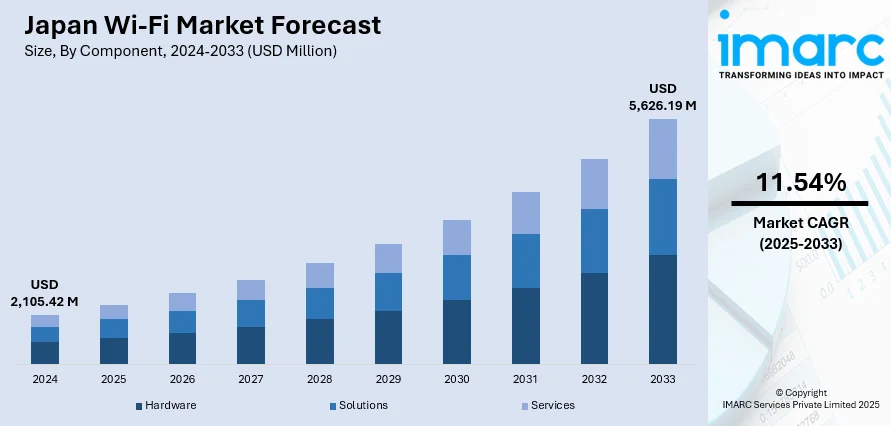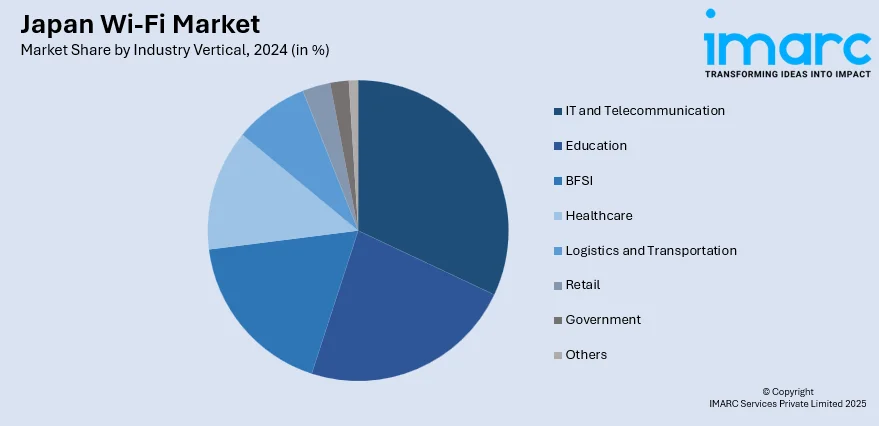
Japan Wi-Fi Market Size, Share, Trends and Forecast by Component, Density, Location Type, Organization Size, Industry Vertical, and Region, 2025-2033
Japan Wi-Fi Market Overview:
The Japan Wi-Fi market size reached USD 2,105.42 Million in 2024. Looking forward, IMARC Group expects the market to reach USD 5,626.19 Million by 2033, exhibiting a growth rate (CAGR) of 11.54% during 2025-2033. The rising proliferation of smart devices, growing adoption of Wi-Fi standards such as Wi-Fi 6 and 6E, integration of Wi-Fi with 5G networks, and emerging technologies like artificial intelligence (AI), augmented reality (AR), and virtual reality (VR), are some of the key factors strengthening the market growth.
|
Report Attribute
|
Key Statistics
|
|---|---|
|
Base Year
|
2024 |
|
Forecast Years
|
2025-2033
|
|
Historical Years
|
2019-2024
|
| Market Size in 2024 | USD 2,105.42 Million |
| Market Forecast in 2033 | USD 5,626.19 Million |
| Market Growth Rate 2025-2033 | 11.54% |
Japan Wi-Fi Market Trends:
Adoption of Wi-Fi 6 and Wi-Fi 6E Technology
The widespread deployment of Wi-Fi 6 and Wi-Fi 6E technologies is a key factor driving Japan's Wi-Fi market. These next-generation Wi-Fi standards provide faster speeds, more capacity, and more dependable connections, which are critical as the number of connected devices grows. In 2023, Japan experienced a 30% year-on-year increase in Wi-Fi 6E device adoption, according to the Japan Information Technology Service Industry Association (JITSA). This surge was fueled by the surging demand for high-speed internet in both residential and business environments. As IoT devices, AR, VR, and ultra-high-definition content become more prevalent, Wi-Fi 6 and Wi-Fi 6E will become increasingly crucial for ensuring stable, high-performance connectivity. Additionally, Wi-Fi 6E operates in the newly available 6 GHz band, offering even higher speeds and lower latency compared to earlier versions. The expanded deployment of Wi-Fi 6 and 6E is further driven by the integration of 5G networks, which enhance the overall wireless ecosystem, positioning these technologies to drive significant market growth.

Expansion of Public Wi-Fi and Smart Cities Infrastructure
Another significant trend driving the growth of Japan’s Wi-Fi market is the expansion of public Wi-Fi networks and the development of smart city infrastructure. As urban areas modernize, Wi-Fi connectivity has become essential for improving the efficiency and accessibility of smart city services, such as transportation, healthcare, and public services. The Japanese government is investing heavily in increasing free public Wi-Fi access, aiming to expand the number of Wi-Fi hotspots by 40% by 2025, particularly in high-traffic public areas like train stations, airports, and shopping districts, according to a report from the Ministry of Internal Affairs and Communications (MIC). This expansion supports Japan’s broader efforts to create more connected and sustainable urban environments. Wi-Fi networks play a critical role in reducing congestion, improving energy efficiency, and providing real-time data for better urban planning. As Japan prepares for global events and embraces innovations like smart transportation and autonomous vehicles, the demand for robust and scalable Wi-Fi networks is expected to grow significantly.
Japan Wi-Fi Market Segmentation:
IMARC Group provides an analysis of the key trends in each segment of the market, along with forecasts at the region/country level for 2025-2033. Our report has categorized the market based on component, density, location type, organization size, and industry vertical.
Component Insights:
- Hardware
- Solutions
- Services
The report has provided a detailed breakup and analysis of the market based on the component. This includes hardware, solutions, and services.
Density Insights:
- High-Density Wi-Fi
- Enterprise-Class Wi-Fi
A detailed breakup and analysis of the market based on the density have also been provided in the report. This includes high-density Wi-Fi and enterprise-class Wi-Fi.
Location Type Insights:
- Indoor
- Outdoor
The report has provided a detailed breakup and analysis of the market based on the location type. This includes indoor and outdoor.
Organization Size Insights:
- Large Enterprises
- Small and Medium-sized Enterprises
A detailed breakup and analysis of the market based on the organization size have also been provided in the report. This includes large enterprises and small and medium-sized enterprises.
Industry Vertical Insights:

- IT and Telecommunication
- Education
- BFSI
- Healthcare
- Logistics and Transportation
- Retail
- Government
- Others
A detailed breakup and analysis of the market based on the industry vertical have also been provided in the report. This includes IT and telecommunication, education, BFSI, healthcare, logistics and transportation, retail, government, and others.
Regional Insights:
- Kanto Region
- Kansai/Kinki Region
- Central/Chubu Region
- Kyushu-Okinawa Region
- Tohoku Region
- Chugoku Region
- Hokkaido Region
- Shikoku Region
The report has also provided a comprehensive analysis of all the major regional markets, which include Kanto Region, Kansai/Kinki Region, Central/Chubu Region, Kyushu-Okinawa Region, Tohoku Region, Chugoku Region, Hokkaido Region, and Shikoku Region.
Competitive Landscape:
The market research report has also provided a comprehensive analysis of the competitive landscape. Competitive analysis such as market structure, key player positioning, top winning strategies, competitive dashboard, and company evaluation quadrant has been covered in the report. Also, detailed profiles of all major companies have been provided.
Japan Wi-Fi Market News:
- January 2025: Japanese mobile carrier KDDI Corporation introduced Starlink's Wi-Fi service on the Hamaya ferry operated by Tokyo Kyushu Ferry. This initiative provided passengers with high-speed internet access during voyages, with speeds up to 220 Mbps, and was part of KDDI's efforts to expand satellite-based connectivity services.
- October 2024: Plume expanded its partnership with J:COM to enhance managed Wi-Fi services across residential, small business, and multi-dwelling unit (MDU) markets. This collaboration introduced Plume's adaptive Wi-Fi solutions—WorkPass for small enterprises and Uprise for MDUs—alongside advanced analytics via the Haystack platform.
- July 2024: KDDI announced plans to equip 100 mountain lodges across Japan with Wi-Fi services powered by Starlink. This expansion aimed to enhance connectivity for hikers in regions like the Japanese Alps and Mt. Fuji.
Japan Wi-Fi Market Report Coverage:
| Report Features | Details |
|---|---|
| Base Year of the Analysis | 2024 |
| Historical Period | 2019-2024 |
| Forecast Period | 2025-2033 |
| Units | Million USD |
| Scope of the Report | Exploration of Historical Trends and Market Outlook, Industry Catalysts and Challenges, Segment-Wise Historical and Future Market Assessment:
|
| Components Covered | Hardware, Solutions, Services |
| Densities Covered | High-Density Wi-Fi, Enterprise-Class Wi-Fi |
| Location Types Covered | Indoor, Outdoor |
| Organization Sizes Covered | Large Enterprises, Small and Medium-sized Enterprises |
| Industry Verticals Covered | IT and Telecommunication, Education, BFSI, Healthcare, Logistics and Transportation, Retail, Government, Others |
| Regions Covered | Kanto Region, Kansai/Kinki Region, Central/Chubu Region, Kyushu-Okinawa Region, Tohoku Region, Chugoku Region, Hokkaido Region, Shikoku Region |
| Customization Scope | 10% Free Customization |
| Post-Sale Analyst Support | 10-12 Weeks |
| Delivery Format | PDF and Excel through Email (We can also provide the editable version of the report in PPT/Word format on special request) |
Key Questions Answered in This Report:
- How has the Japan Wi-Fi market performed so far and how will it perform in the coming years?
- What is the breakup of the Japan Wi-Fi market on the basis of component?
- What is the breakup of the Japan Wi-Fi market on the basis of density?
- What is the breakup of the Japan Wi-Fi market on the basis of location type?
- What is the breakup of the Japan Wi-Fi market on the basis of organization size?
- What is the breakup of the Japan Wi-Fi market on the basis of industry vertical?
- What are the various stages in the value chain of the Japan Wi-Fi market?
- What are the key driving factors and challenges in the Japan Wi-Fi market?
- What is the structure of the Japan Wi-Fi market and who are the key players?
- What is the degree of competition in the Japan Wi-Fi market?
Key Benefits for Stakeholders:
- IMARC’s industry report offers a comprehensive quantitative analysis of various market segments, historical and current market trends, market forecasts, and dynamics of the Japan Wi-Fi market from 2019-2033.
- The research report provides the latest information on the market drivers, challenges, and opportunities in the Japan Wi-Fi market.
- Porter's five forces analysis assist stakeholders in assessing the impact of new entrants, competitive rivalry, supplier power, buyer power, and the threat of substitution. It helps stakeholders to analyze the level of competition within the Japan Wi-Fi industry and its attractiveness.
- Competitive landscape allows stakeholders to understand their competitive environment and provides an insight into the current positions of key players in the market.
Need more help?
- Speak to our experienced analysts for insights on the current market scenarios.
- Include additional segments and countries to customize the report as per your requirement.
- Gain an unparalleled competitive advantage in your domain by understanding how to utilize the report and positively impacting your operations and revenue.
- For further assistance, please connect with our analysts.
 Request Customization
Request Customization
 Speak to an Analyst
Speak to an Analyst
 Request Brochure
Request Brochure
 Inquire Before Buying
Inquire Before Buying




.webp)




.webp)












